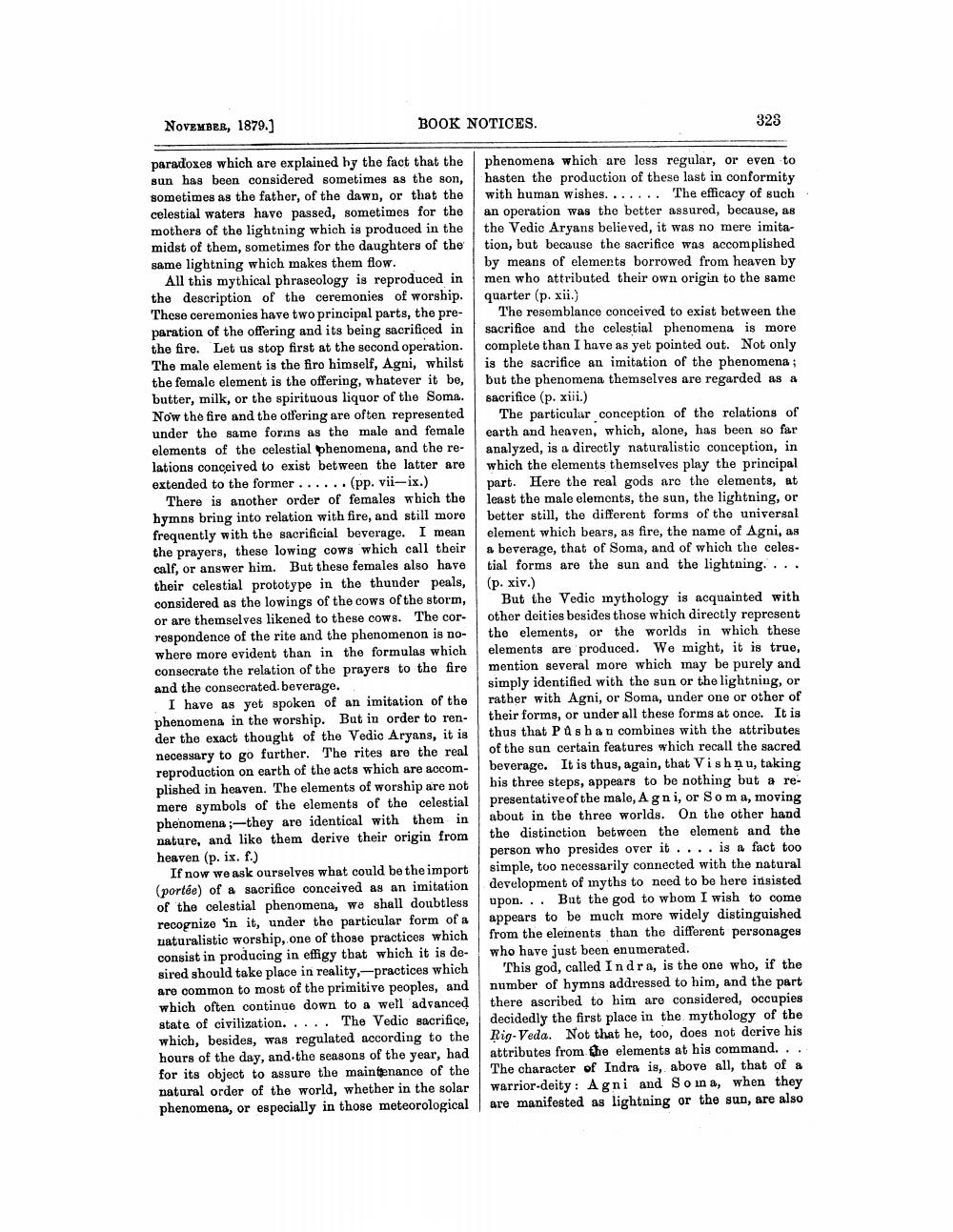________________
NOVEMBER, 1879.)
BOOK NOTICES.
323
paradoxes which are explained by the fact that the sun has been considered sometimes as the son, sometimes as the father, of the dawn, or that the celestial waters have passed, sometimes for the mothers of the lightning which is produced in the midst of them, sometimes for the daughters of the same lightning which makes them flow.
All this mythical phraseology is reproduced in the description of the ceremonies of worship. These ceremonies have two principal parts, the pre- paration of the offering and its being sacrificed in the fire. Let us stop first at the second operation. The male element is the firo himself, Agni, whilst the female element is the offering, whatever it be, butter, milk, or the spirituous liquor of the Soma. Now the fire and the offering are often represented under the same forins as the male and female elements of the celestial phenomena, and the relations conceived to exist between the latter are extended to the former . . . . . . (pp. vii-ix.)
There is another order of females which the hymns bring into relation with fire, and still more freqnently with the sacrificial beverage. I mean the prayers, these lowing cows which call their calf, or answer him. But these females also have their celestial prototype in the thunder peals, considered as the lowings of the cows of the storm, or are themselves likened to these cows. The cor. respondence of the rite and the phenomenon is nowhere more evident than in the formulas which consecrate the relation of the prayers to the fire and the consecrated. beverage.
I have as yet spoken of an imitation of the phenomena in the worship. But in order to render the exact thought of the Vedic Aryans, it is necessary to go further. The rites are the real reproduction on earth of the acts which are accomplished in heaven. The elements of worship are not
symbols of the elements of the celestial phenomena ;-they are identical with them in nature, and like them derive their origin from heaven (p. ix. f.)
If now we ask ourselves what could be the import (portée) of a sacrifice conceived as an imitation of the celestial phenomena, we shall doubtless recognize in it, under the particular form of a naturalistic worship, one of those practices which consist in producing in effigy that which it is de sired should take place in reality, -practices which are common to most of the primitive peoples, and which often continuo down to a well advanced state of civilization. . . . . The Vedio sacrifice, which, besides, was regulated according to the hours of the day, and the seasons of the year, had for its object to assure the maintenance of the natural order of the world, whether in the solar phenomena, or especially in those meteorological
phenomena which are less regular, or even to hasten the production of these last in conformity with human wishes....... The efficacy of such an operation was the better assured, because, as the Vedic Aryans believed, it was no mere imitation, but because the sacrifice was accomplished by means of elements borrowed from heaven by men who attributed their own origin to the same quarter (p. xii.)
The resemblance conceived to exist between the sacrifice and the celestial phenomena is more complete than I have as yet pointed out. Not only is the sacrifice an imitation of the phenomena ; but the phenomena themselves are regarded as a sacrifice (p. xiii.)
The particular conception of the relations of earth and heaven, which, alone, has been so far analyzed, is a directly naturalistic conception, in which the elements themselves play the principal part. Here the real gods aro the elements, at least the male elements, the sun, the lightning, or better still, the different forms of the universal element which bears, as fire, the name of Agni, as a beverage, that of Soma, and of which the celestial forms are the sun and the lightning. ... (p. xiv.)
But the Vedic mythology is acquainted with other deities besides those which directly represent the elements, or the worlds in which these elements are produced. We might, it is true, mention several more which may be purely and simply identified with the sun or the lightning, or rather with Agni, or Soma, under one or other of their forms, or under all these forms at once. It is thus that Pasha n combines with the attributes of the sun certain features which recall the sacred beverage. It is thus, again, that Vishņu, taking his three steps, appears to be nothing but a representative of the male, A gni, or Soma, moving about in the three worlds. On the other hand the distinction between the element and the person who presides over it.... is a fact too simple, too necessarily connected with the natural development of myths to need to be here insisted upon... But the god to whom I wish to come appears to be much more widely distinguished from the elements than the different personages who have just been enumerated.
This god, called Indra, is the one who, if the number of hymns addressed to him, and the part there ascribed to him are considered, occupies decidedly the first place in the mythology of the Rig Veda. Not that he, too, does not derive his attributes from the elements at his command... The character of Indra is, above all, that of a warrior-deity: Agni and So in a, when they are manifested as lightning or the sun, are also




